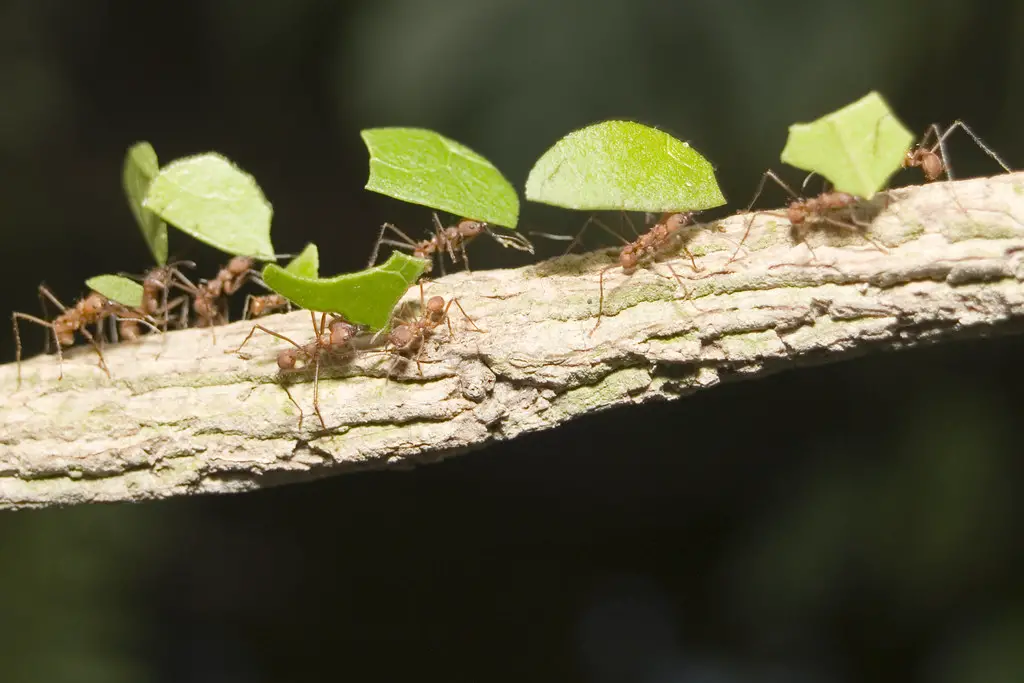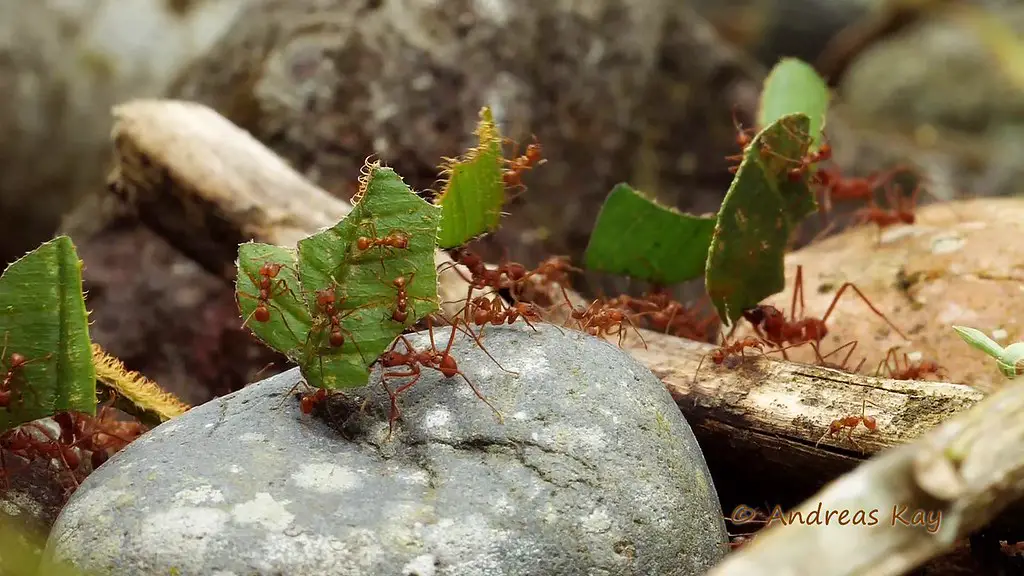Have you ever wondered about the tireless workers that toil away, shaping the landscape around them? Welcome to the world of leafcutter ants, where determination, teamwork, and ingenuity converge in shaping the landscape. These tireless workers are nature’s true farmers, opting for the lush rainforest canopies as their agricultural playground.
Picture an army of ants marching in perfect unison, carrying large leaves back to their colonies, leaving behind a vibrant path of greenery. But their purpose is unique – they cultivate a specialized fungus for nutrition, tending to their fungal gardens with unmatched skill.
Leaf cutter ants have mastered pest control through a fascinating symbiotic relationship with bacteria, safeguarding their crops.
Amid their success, challenges persist, from leaf selection to maintaining colony-fungus balance.
Marvel at these tiny farmers and draw parallels to our own practices. Leafcutter ants teach cooperation, resourcefulness, and the delicate harmony sustaining life.
Spot these industrious leaf cutters in the rainforest, exemplifying the power of determination and teamwork in thriving communities
What Do Leafcutter Ant Looks Like?
Striking Appearance
- Relatively small in size, measuring about 0.2 to 0.6 inches
- Vivid coloration: reddish-brown to black with contrasting orange or yellowish legs and antennae
Adaptations for Farming
- Robust and sturdy bodies with powerful mandibles for cutting and carrying leaves
- Segmented bodies: head, thorax, and abdomen
Navigational Prowess
- Long and slender antennas for precise navigation and communication within colonies
Industrious Farming Endeavors
- Exceptional organization and efficiency in their movements
- A reflection of their well-developed social structure and collective strength
Lessons in Cooperation
- Exemplifying the wonders of the animal kingdom and the power of cooperation
- Marvels of nature, these tiny farmers teach the importance of collaboration and unity
Leafcutter Ant Queen
The Leafcutter Ant Queen is the mighty matriarch of her colony, responsible for laying eggs and ensuring its continuity. Her transformation from a regular ant to royalty involves proper nutrition and mating during her nuptial flight.
With an extended lifespan, she produces workers, soldiers, and new queens to maintain the colony’s strength. Challenges include predators and environmental threats, requiring her resilience for survival.
The queen symbolizes leadership and cooperation in the leafcutter ant ecosystem, playing a vital role in their bustling world.
Her regal presence and remarkable contributions command admiration and respect from her devoted worker ants.
Leafcutter Ants Habitat

The bustling habitat of leafcutter ants is a captivating sight to behold. But why do they choose specific environments to thrive in and what draws them to these locations?
- Nurturing Fungus Gardens: Leafcutter ants seek lush habitats abundant with fresh leaves, crucial for cultivating their specialized fungus, the primary source of nutrition.
- Embracing Canopy Life: High up in the treetops, leafcutter ants find safety and a rich supply of leaves, optimizing temperature and humidity for their thriving colonies.
- Rainforest Diversity: The leaf-cutter ant’s habitat in diverse rainforests ensures a varied leaf selection, contributing to healthier fungal gardens and robust colonies.
- Harmony with Nature: Leaf-cutter ants coexist harmoniously in the rainforest ecosystem, vital for nutrient cycling and maintaining ecological balance.
- Adaptability to Human Proximity: Displaying remarkable adaptability, leaf-cutter ants may establish nests near human settlements while predominantly thriving in undisturbed habitats.
- Conserving Leaf-Cutter Ant Habitats: Preserving natural environments, like rainforests, is essential for sustaining the flourishing leaf-cutter ant colonies and the delicate balance they contribute to the broader ecosystem.
What Does a Leafcutter Ant Eat?
Leafcutter ants are nature’s true farmers, but what exactly do they eat?
Leaf-cutter ants, the culinary innovators of nature, have a unique and fascinating feeding strategy. Instead of directly consuming the leaves they tirelessly collect, they employ a remarkable farming approach.
These industrious ants cultivate a specialized fungus, which serves as their primary source of nutrition. They expertly cut leaves and transport them back to their nests, where they carefully tend to their fungal gardens.
This mutualistic relationship between leafcutters and fungi is a testament to nature’s intricacy and balance.
While the ants benefit from the nourishing fungus, the fungi thrive on the nutritious leaf matter provided by the ants. It’s a stunning display of cooperation and adaptability, highlighting the interdependence of different species in ecosystems.
The leaf-cutter ants’ ability to harness the power of fungi for sustenance showcases the marvels of the natural world and the ingenious ways in which organisms have evolved to thrive in their environments.
What Eats a Leafcutter Ant?
In the intricate web of the rainforest ecosystem, leaf-cutter ants are not immune to predation. Several natural predators pose a threat to these diligent workers.
Some of the common leafcutter ant predators include:
- Anteaters: Anteaters are specialized predators that feed primarily on ants and termites. They use their long tongues to extract the ants from their nests.
- Spider Wasps: Some species of spider wasps are known to target and parasitize leaf-cutter ant colonies. They lay their eggs on paralyzed ants, and the wasp larvae consume the ants as they develop.
- Army Ants: Army ants are aggressive predators that raid and consume other ant colonies, including leaf-cutter ants.
- Birds: Certain bird species, such as woodpeckers and antbirds, feed on ants, including leaf-cutter ants.
- Reptiles: Some reptiles, like lizards and certain species of snakes, may prey on ants, including leaf-cutter ants.
These predators play a vital role in controlling leaf-cutter ant populations and maintaining the ecological balance in the rainforest. As with all species, leaf-cutter ants are an integral part of the food chain, contributing to the complex interactions and dynamics within their habitat.
Leafcutter Ants Bite
Do leaf-cutter ants bite? Leaf-cutter ants are not typically known for their biting behavior.
Unlike some other ant species, they are not aggressive toward humans and do not pose a significant threat. Instead, their primary defense mechanism is their powerful mandibles, which they use for cutting leaves and other plant material.
If provoked or threatened, a leafcutter ant may bite as a defensive reaction, but it is usually not severe. Their bites are generally not harmful to humans, and the pain is typically mild and short-lived. However, some individuals may experience mild irritation or allergic reactions to ant bites.
While leafcutter ants are fascinating creatures with complex social structures and impressive foraging abilities, they are not a major concern for humans in terms of biting or causing harm.
If you encounter leaf-cutter ants, it is best to observe them from a safe distance and appreciate their incredible behaviors from afar.
As with any encounter with wildlife, it is essential to respect their space and avoid disturbing their nests to prevent unnecessary conflicts.
How to Get Rid of Leafcutter Ants?
Leaf-cutter ants can be persistent pests, but with the right approach, you can effectively get rid of them.
Follow these steps to control and eliminate leaf cutter ant infestations:
- Identify the Ant Trails: Locate the trails the ants use to carry leaves back to their nests. This will help you understand their entry points and target the problem areas.
- Seal Entry Points: Use caulk or weather stripping to seal any cracks or gaps in your home’s exterior. This will prevent ants from entering your living spaces.
- Trim Vegetation: Keep vegetation away from the foundation of your house. Trim branches and plants that may provide a bridge for the ants to access your home.
- Apply Insecticides: Use ant-specific insecticides to treat the ant trails and nests. Follow the product instructions carefully and apply the insecticide as directed.
- Use Ant Baits: Place ant baits near their trails. The ants will carry the bait back to their nests, effectively eliminating the colony.
- Remove Food Sources: Keep your home clean and free of food crumbs or spills that may attract ants.
- Consult Pest Control Professionals: If the infestation persists, consider seeking help from pest control experts who can provide specialized treatments.
By following these steps, you can successfully get rid of leaf-cutter ants and protect your home from their persistent activities.
Conclusion
Leafcutter ants embody the marvels of nature’s ingenuity, forming intricate communities as true farmers of the rainforest. Their synchronized efforts in cultivating fungal gardens and adapting to challenges underscore the power of cooperation and resilience. These tiny architects sculpt landscapes, leaving a trail of greenery in their wake. Their interactions with predators, intricate feeding strategies, and complex social structures enrich the rainforest ecosystem. Observing leaf-cutter ants offers a glimpse into the profound balance and interdependence that sustains life on Earth.



